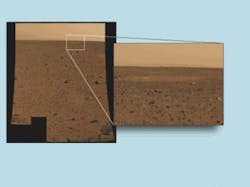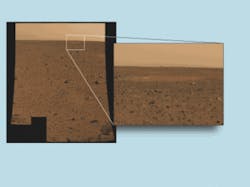Spirit reveals Mars in stereo color
Concluding a seven-month, 487-million-kilometer space ride, NASA's exploratory rover Spirit landed on Mars at 11:35 EST on Jan. 3—if bouncing and rolling for a few minutes on its four six-lobed airbags could be called landing. Soon after coming to a standstill and radioing back to Earth, the rover began transmitting monochrome images of its surroundings—the flat interior of Gusev Crater, a site chosen for the possibility that it once was underwater, and thus habitable for life. Four days later, NASA released this photo, which is the first color image from the rover and, at press time, the highest-resolution image ever obtained of another planet.
The Spirit rover contains six cameras for navigation and three intended for scientific investigation. Of the three scientific CCD imagers, two—the panoramic cameras, or Pancams—are used in concert to obtain stereo images. The CCD image sensor chips, designed by NASA's Jet Propulsion Laboratory (JPL) in Pasadena, CA, were manufactured at DALSA's semiconductor wafer production facility in Bromont, Quebec, according to DALSA (Waterloo, Ontario). Each 270-gram Pancam has a 0.3-mrad resolution and eight optical filters. Between the two cameras, there are a total of 11 different types of color filters, as well as two-color solar-imaging filters to take multispectral images. The Pancams can rotate a full 360° on their shared mast and swing up or down through 180° of elevation, and can produce image mosaics as large as 4000 × 24,000 pixels.
The third camera, the Microscopic Imager, has a 1024 x 1024-pixel field of view and is located on the arm of the rover. It will produce monochrome microscopic images of rocks and soil, either in their pristine state or freshly exposed by the rover's rock-abrasion tool. The hope is to find sedimentary rocks and glean from them a bit of the history of water on the planet. A second, identical rover, the Opportunity, is scheduled to land on the opposite side of Mars in late January.

